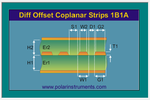tony_lth
Advanced Member level 5

Why the separation is twice times of the trace width?
For difference offset Coplanar strips,
If the trace width W1 is 60um.
Option1: S1=120um, D1=120um, then get Zdiff=90.99 ohms.
Option2: S1=300um, D1=300um, then get Zdiff=98.93 ohms.
Someone said that S1 and D1 should better be twice times of W1. So he denied option2 because of not 100 ohms diff impedance.
I think option2 is feasible, who can give comments on that? Attached Thumbnails
For difference offset Coplanar strips,
If the trace width W1 is 60um.
Option1: S1=120um, D1=120um, then get Zdiff=90.99 ohms.
Option2: S1=300um, D1=300um, then get Zdiff=98.93 ohms.
Someone said that S1 and D1 should better be twice times of W1. So he denied option2 because of not 100 ohms diff impedance.
I think option2 is feasible, who can give comments on that? Attached Thumbnails

